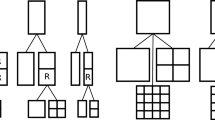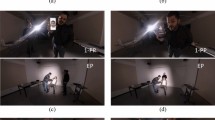Abstract
Finding an exciting event in a lengthy spherical (360\(^{\circ }\)) surveillance video having an unlimited Field of View (FoV) is challenging and time-consuming. Hence, this paper proposes a novel spherical video synopsis framework to condense the 360\(^{\circ }\) surveillance video. It also incorporates an action recognition module, making monitoring important activities easy, followed by less critical ones. The framework provides flexibility for generating synopsis from spherical videos based on the viewer’s preferences. The preferences include customized FoV visualization of the generated spherical synopsis video and FoV-based personalized synopsis video generation. In the first case, the viewer experience is customized by viewing the interested FoV based on the head movement over the generated spherical synopsis video. In the second case, the viewer experience is personalized by generating a synopsis video only for the viewer’s interested FoV dynamically. Overall, the proposed framework creates a condensed immersive video using various optimization techniques by reducing collisions between objects, preserving all events with interaction, chronological ordering, and showing the viewer only the specified number of objects per frame in the synopsis video recognizing important actions. Exhaustive experimental analysis of the used optimization algorithm is performed for the proposed video synopsis framework applicable for unlimited FoV. The analysis includes a video synopsis of varying lengths and predefined lengths.
























Similar content being viewed by others
References
Drisya S S, Ansuman M and Priyadharshini S 2022 360-degree image classification and viewport prediction using deep neural networks. In: Advances in Distributed Computing and Machine Learning. Springer, pp.483–492
Priyadharshini S and Ansuman M 2020 360\(^{\circ }\) user-generated videos: Current research and future trends.High Performance Vision Intelligence: Recent Advances. pp.117–135
Yu-Chuan S, Dinesh J, and Kristen G 2016 Pano2vid: Automatic cinematography for watching 360\(^{\circ }\) videos.In: Asian Conference on Computer Vision. Springer, pp. 154–171
Yu-Chuan S and Kristen G 2017 Making 360 video watchable in 2d: Learning videography for click free viewing. In: 2017 IEEE Conference on Computer Vision and Pattern Recognition (CVPR). IEEE, pp. 1368–1376
Hou-Ning Hu, Yen-Chen Lin, Ming-Yu Liu, Hsien-Tzu Cheng, Yung-Ju Chang and Min Sun 2017 Deep 360 pilot: Learning a deep agent for piloting through 360 sports videos. In: 2017 IEEE Conference on Computer Vision and Pattern Recognition (CVPR). IEEE, pp. 1396–1405
Youngjae Y, Sangho L, Joonil N, Jaeyun K, and Gunhee K 2018 A deep ranking model for spatio-temporal highlight detection from a 360 video. In Proceedings of the AAAI Conference on Artificial Intelligence, volume 32
Sangho L, Jinyoung S, Youngjae Y, and Gunhee K 2018 A memory network approach for story-based temporal summarization of 360 videos. In: Proceedings of the IEEE Conference on Computer Vision and Pattern Recognition, pp. 1410–1419
Wei-Sheng L, Yujia H, Neel J, Christopher B, Ming-Hsuan Y, and Sing Bing Kang 2017 Semantic-driven generation of hyperlapse from 360 degree video. IEEE transactions on visualization and computer graphics, 24: 2610–2621
Yael P, Alex R, and Shmuel P 2008 Nonchronological video synopsis and indexing. IEEE transactions on pattern analysis and machine intelligence, 30: 1971–1984
Arif A, Samarjit K, Debi Prosad D, Renuka P, Lee S, Choi H and I Kim 2017 Video synopsis generation using spatio-temporal groups. In: 2017 IEEE International Conference on Signal and Image Processing Applications (ICSIPA). IEEE, pp. 512–517
Giovanna P, Dario A, Filippo S, and Sebastiano B 2019 A new framework for studying tubes rearrangement strategies in surveillance video synopsis. In: 2019 IEEE international conference on image processing (ICIP). IEEE, pp. 664–668
Sekh Arif A, Debi Prosad D, Samarjit K, Renuka P, Seung-Cheol L, Heeseung C, Gi Pyo N, and Ig-Jae K 2019 Query-based video synopsis for intelligent traffic monitoring applications. IEEE Transactions on Intelligent Transportation Systems,21: 3457–3468
Subhankar G, Suvendu R, Banshidhar M, and MNS S 2020 An improved surveillance video synopsis framework: a hsatlbo optimization approach. Multimedia Tools and Applications, 79: 4429–4461
Shengbo C, Xianrui L, Yiyong H, Congcong Z, and Huaikou M 2020 Video synopsis based on attention mechanism and local transparent processing. IEEE Access, 8: 92603–92614
Namitha K, Athi N, and Geetha M 2021 Interactive visualization-based surveillance video synopsis. Applied Intelligence, pp. 1–22
Subhankar G, Suvendu R, Himansu D and MNS S 2021 Gan based efficient foreground extraction and hgwosa based optimization for video synopsis generation. Digital Signal Processing, 111: 102988
Jianqing Z, Shengcai L, and Stan Z L 2015 Multicamera joint video synopsis. IEEE Transactions on Circuits and Systems for Video Technology, 26: 1058–1069
Ansuman M, Pankaj K S, Banshidhar M, and Sudarshan P 2016 Mvs: A multi-view video synopsis framework. Signal Processing: Image Communication, 42:31–44
Shaoqing R, Kaiming H, Ross G, and Jian S 2015 Faster r-cnn: Towards real-time object detection with region proposal networks. Advances in neural information processing systems, 28: 91–99
Namitha K and Athi N 2020 Preserving interactions among moving objects in surveillance video synopsis. Multimedia Tools and Applications, 79: 32331–32360
Nicolai W, Alex B, and Dietrich P 2017 Simple online and realtime tracking with a deep association metric. In: 2017 IEEE international conference on image processing (ICIP). IEEE, pp. 3645–3649
Yu K and Yun F 2018 Human action recognition and prediction: A survey. arXiv preprintarXiv:1806.11230
Hong-Bo Z, Yi-Xiang Z, Bineng Z, Qing L, Lijie Y, Ji-Xiang D and Duan-Sheng C 2019 A comprehensive survey of vision-based human action recognition methods. Sensors, 19: 1005
Moez B, Franck M, Christian W, Christophe G, and Atilla B 2011 Sequential deep learning for human action recognition. In: International workshop on human behavior understanding. Springer, pp. 29–39
Gao H, Zhuang L, Laurens Van D M, and Kilian Q W 2017 Densely connected convolutional networks. In: Proceedings of the IEEE conference on computer vision and pattern recognition, pp. 4700–4708
Sepp H and Jürgen S 1997 Long short-term memory. Neural computation, 9: 1735–1780
Christian S, Ivan L and Barbara C 2004 Recognizing human actions: a local svm approach. In: Proceedings of the 17th International Conference on Pattern Recognition, 2004. ICPR 2004.. volume 3, IEEE, pp. 32–36
Fatma A H, Kashif H, Essam H H, Mai S M, and Walid Al-A 2021 Archimedes optimization algorithm: a new metaheuristic algorithm for solving optimization problems. Applied Intelligence, 51: 1531–1551
Hazim N G and Károly J 2020 Dynamic differential annealed optimization: New metaheuristic optimization algorithm for engineering applications. Applied Soft Computing, 93: 106392
Tong Y, Maosen X, Caiwen M, Chao S and Peng L 2014 Object based video synopsis. In: 2014 IEEE workshop on advanced research and technology in industry applications (WARTIA). IEEE, pp. 1138–1141
Saleh S, Mohammad Sadegh H, and Akbar R 2017 A fuzzy multi-objective hybrid tlbo–pso approach to select the associated genes with breast cancer. Signal processing, 131: 58–65
Yanhui C and Dengxu H 2021 A hybrid whale optimization with seagull algorithm for global optimization problems. Mathematical Problems in Engineering
Reza A, Ramin H, Koorush Z, and Bahareh H 2012 A multi-objective artificial bee colony algorithm. Swarm and Evolutionary Computation, 2: 39–52
Mona M M and Rasha S 2021 Object-based video synopsis approach using particle swarm optimization. Signal, Image and Video Processing, 15: 761–768
Alex R, Yael P, and Shmuel P 2006 Making a long video short: Dynamic video synopsis. In: 2006 IEEE Computer Society Conference on Computer Vision and Pattern Recognition (CVPR’06). IEEE, volume 1, pp. 435–441
Gaurav D and Vijay K 2019 Seagull optimization algorithm: Theory and its applications for large-scale industrial engineering problems. Knowledge-Based Systems, 165: 169–196
R Venkata R 2016 Teaching-learning-based optimization algorithm. In: Teaching learning based optimization algorithm. Springer, pp. 9–39
Seyedali M and Andrew L 2016 The whale optimization algorithm. Advances in engineering software, 95: 51–67
George A A and Steven L F 2007 How many objects can you track?: Evidence for a resource-limited attentive tracking mechanism. Journal of vision, 7: 14–14
Patrick P, Michel G and Andrew B 2003 Poisson image editing. In: ACM SIGGRAPH 2003 Papers, pp. 313–318
Yan Y, Elena A and Jill B Joint video exploration team (jvet) of itu-t sg 16 wp 3 and iso/iec jtc 1/sc 29/wg 11.
Eric W W 2005 Spherical coordinates. https://mathworld.wolfram.com/
Xinwei C, Ali T Z K and Walid S 2020 Deep learning for content-based personalized viewport prediction of 360-degree vr videos. IEEE Networking Letters, 2: 81–84
Cort J W and Kenji M 2005 Advantages of the mean absolute error (mae) over the root mean square error (rmse) in assessing average model performance. Climate research, 30: 79–82
Author information
Authors and Affiliations
Corresponding author
Rights and permissions
About this article
Cite this article
PRIYADHARSHINI, S., MAHAPATRA, A. PanoSyn: immersive video synopsis for spherical surveillance video. Sādhanā 47, 167 (2022). https://doi.org/10.1007/s12046-022-01937-9
Received:
Revised:
Accepted:
Published:
DOI: https://doi.org/10.1007/s12046-022-01937-9




